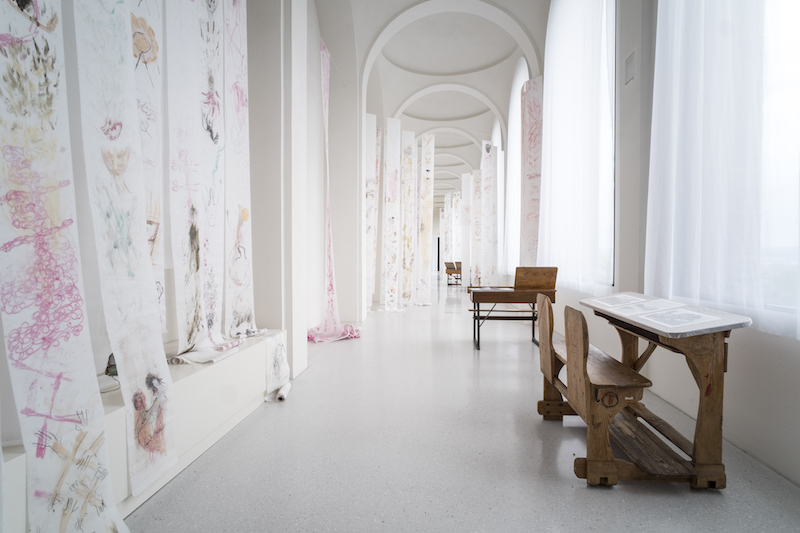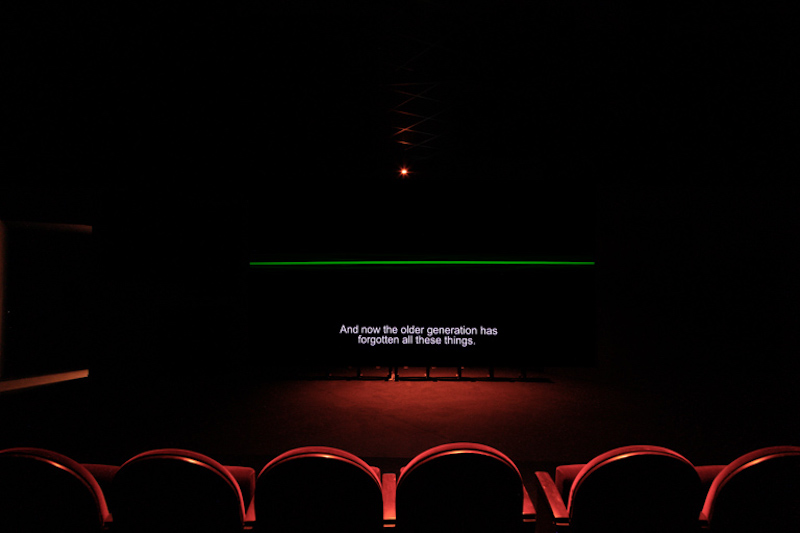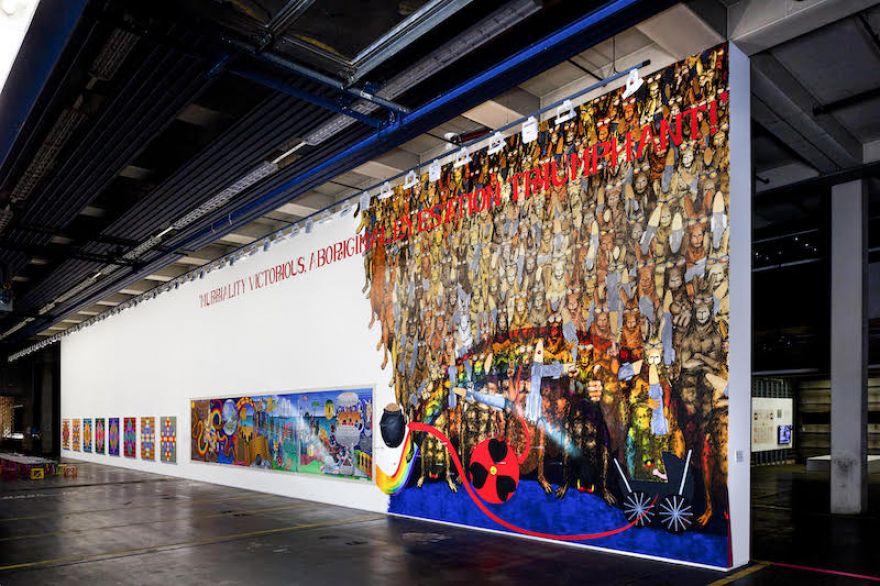It can certainly be said the team behind documenta 14 have learnt something from the first ever twin city edition. Alongside the curatorial current in Kassel that wrestles with the geographic, economic, and cultural distance between the two host cities, runs an underlying, and perhaps more pervasive, thread that offers up a broad colonial self-consciousness. From explicit references to violence, genocide, and slavery to art practices and storytelling traditions that narrate adjacent world histories and art histories, the selection of artists and works pursues a self-aware confrontation of the historical and present day realities of global imperialist legacies.
Gordon Hookey: ‘MURRILAND!’, Oil on linen and mural, 2 × 10 m, mural dimensions variable, Neue Neue Galerie (Neue Hauptpost), Kassel, 2017 // Photo by Mathias Völzke // © Gordon Hookey/VG Bild-Kunst, Bonn 2017, documenta 14
One such confrontation that arrests viewers as they walk into the Neue Hauptpost, dubbed the Neue Neue Galerie and a new edition to the principal venues for documenta 14, is ‘MURRILAND!’, 2017, a ten metre wide oil on linen and mural work by Aboriginal Australian artist, Gordon Hookey. In this condemning visual treatise on Australian colonial history, Hookey juxtaposes imagery of Aboriginal cultural identity and explicit symbols of colonial violence and oppression with a colonial narrative told through the plummy voice of the depicted British settlers and the collective memory of contemporary Australian identity. In contrast to the oral traditions in Aboriginal cultures, Hookey directly references the mechanisms of a written language that are still working to delegitimize the lived trauma of indigenous peoples; the phrase ‘black armband’ is written over and over, a term that emerged in contemporary national identity debates to criticise the negative emphasis on violence in Australian history.
This denial or lack of remembrance of history that ‘MURRILAND!’ points to features in many expressions across the thirty plus venues of the exhibition. In parallel installations in Athens and Kassel, titled ‘The Missing Link. Dicolonisation Education by Mrs Smiling Stone’, 2017, the Dakar-born artist Pélagie Gbaguidi aims to unveil the processes of forgetting in history. Lining a corridor of the Neue Galerie are ceiling-to-floor hanging drawings and black and white photographs on old school desks covered in translucent paper. The fogged images by South African photographer Peter Magubane capture violent memories of Apartheid; a half-visible, half-forgotten archive. Gbaguidi’s school desks posit education and knowledge circulation as the antidote to this collective amnesia. A documentary video work by Susan Hiller, ‘Lost and Found’, 2016, shown in near complete darkness at the new Grimmwelt Kassel museum, transmits voices quite literally silenced by history. The subtitled clips of extinct or endangered languages, often by one of the last remaining speakers, is a poignant reminder of the fragility of cultural traditions in some pockets of the world.

Pélagie Gbaguidi: ‘The Missing Link. Dicolonisation Education by Mrs Smiling Stone’,
various materials, installation view, Neue Galerie, Kassel, 2017 // Photo by Mathias Völzke

Susan Hiller: ‘Lost and Found’, digital video, installation view, Grimmwelt Kassel, Kassel, 2016 // Photo by Liz Eve // © Susan Hiller/VG Bild-Kunst, Bonn 2017
Many of the narratives that deal with colonial legacies at documenta 14 are tied to cultural practices threatened by, or lost to, the imperialist machine. Aboubakar Fofana has spent much of his life researching, learning and mastering the practice of live-culture indigo dying, a practice native to, yet all but forgotten in, West Africa. Desire for the rare pigment, symbolic of wealth, commercialised the practice and fueled the African slave trade and land extraction from indigenous peoples by British colonial powers. After an uprising of indigo farmers in Bengal in 1859, the same colonial greed drove the prompt development of synthetic dying techniques. Fofana’s installation, ‘Fundi (Uprising)’, 2017, of living indigo plants and hanging dyed textiles in the bright and airy Documenta Halle, carry the weight of years of research, centuries of tradition, and a dedication to the future.

Aboubakar Fofana: ‘Fundi (Uprising)’, various materials, installation view, documenta Halle, Kassel, 2017 // Photo by Roman März
The historical consciousness of the exhibition comes to a head at the Neue Galerie, described in the Kassel map booklet as “the site of documenta 14’s memory”. This memory crosses continents and time periods, hosting a gigantic selection of mostly historical works, and in parts seeming like a modernist and contemporary art survey of the global south. Perhaps this wing of the exhibition is better described as the site of documenta 14’s guilty conscience. Found here are topics of stolen art booty, Nazi histories, western cultural imperialism, and contemporary art world imperialism. Unlike the aforementioned works, many of the works in the Neue Galerie suffer from a lack of contextual breathing space. In this setting, some of the artists selected for their contribution to alternative global art histories seem plucked from their own historical contexts. This vast grouping runs the risk of defining these artists by what they are not, which is part of the western canon. The exhibition charges these works with the job of countering a dominant colonial narrative, yet without the autonomy granted to works such as those by Hookey, Gbaguidi, and Fofana, they are sucked into the role of helping to define it.

Theo Eshetu: ‘Atlas Fractured’, digital video projected on banner, Neue Neue Galerie (Neue Hauptpost), Kassel, 2017 // Photo by Mathias Völzke
Exhibition Info
DOCUMENTA 14
Group Show: ‘Learning From Athens’
Athens Exhibition: Apr. 8 – Jul. 16, 2017
Kassel Exhibition: Jun. 10 – Sep. 17, 2017
Full program: documenta14.de
Various locations in Athens and Kassel









